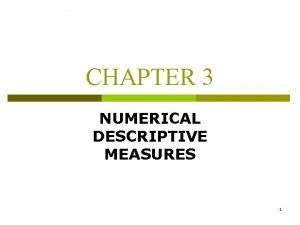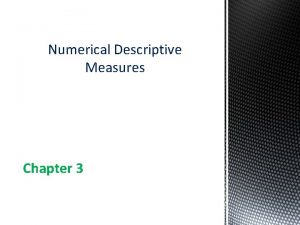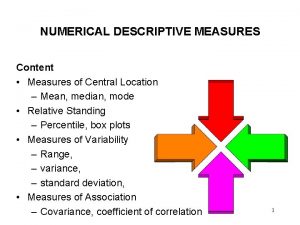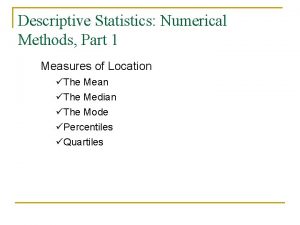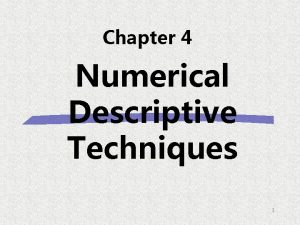Chapter 3 Descriptive Statistics Numerical Methods I Measures








- Slides: 8

Chapter 3 Descriptive Statistics: Numerical Methods

I. Measures of Location Quantitative data is described with measures of location and measures of dispersion. Measures of location are also called measures of central tendency. Examples include the mean, median, and mode.

A. Mean • Often referred to as the “average”, the mean is calculated as: • Sample mean • Population mean

B. Trimmed Mean • Extremely high or low values will affect the mean and possibly lead to mistaken conclusions. • The trimmed mean would drop the upper and lower 5% of the data. This removes extreme values.

C. Median • This is the value in the middle of the data when the data are rank ordered from smallest to largest. Ex. 1, 2, 3, 4, 5. The median is 3. Ex. 2, 4, 6, 8, 10, 12 The median is the mean of the middle two values: (6+8)/2=7

D. Mode • The mode is the value in a sample that appears with the greatest frequency. Ex. 1, 2, 3, 4, 4, 4, 5 The mode is 4. Ex. 1, 2, 2, 3, 3, 4 There are two modes, 2 and 3. Statisticians rarely report more than two modes.

E. Percentiles • The pth percentile is a value such that at least p% of the items take this value or less and at least (100 -p)% of the items take this value or more. • A good example of percentiles is how SAT scores are reported. When you’re told you are in the 90 th percentile it means only 10% of the scores were above yours.

How to calculate percentiles. 1. Rank order the data. 2. Compute an index: i=(p/100)*n 3. a. If i isn’t an integer, round up. The next integer greater than i is the position of the pth percentile. b. If i is an integer, the pth percentile is the average for the data values in positions i and (i+1).

